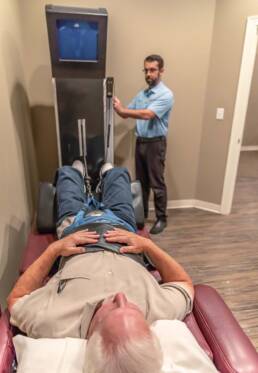During a car accident, the most vulnerable part of a person’s body is the neck area. This is the part of the body that is most apt to get “jerked” and tossed about as the accident is taking place.
If you have recently been involved in a car accident, your top injury concerns should be your back and neck areas. If your injuries were significant, you most likely sought medical intervention at a hospital or from a medical professional. If by chance you didn’t feel you were experiencing any issues that required that level of scrutiny, caution is warranted.
You see, neck and back injuries have a habit of “laying in wait” in the hours and days after the accident has taken place. Sometimes, injuries and pain get masked by the body’s sudden release of adrenaline. It’s only when the adrenaline subsides and the body starts to relax that pain and injury issues might move to the forefront.
Assuming you are starting to suspect that something is amiss in your neck, your curiosity might be asking, “What kinds of neck injuries might you have incurred?”
In an attempt to answer your query, the following information will be directed toward the five (5) most common neck injuries that will occur during a car accident.
1. Whiplash
If you ever saw a movie where one of the characters was entering a courtroom with an oversized brace on their neck area, they were probably indicating they had whiplash from a car accident. It’s a real condition that is very common among people who get hit from behind by another vehicle. The condition can also occur during a head-on collision with a stationary object.
Whiplash occurs when the head is first thrust forward and then violently snaps back. This causes tremendous stress on the neck bones, ligaments, vertebrae, and the discs that reside between the vertebrae. The damage and pain created from this action are often quite significant. The symptoms of Whiplash include:
- Neck stiffness and increasing pain with neck movements
- Pain ranging from the shoulders down into the hands
- Numbness in the upper extremities
- Loss of range of motion in the neck and shoulders
- Blurred vision and dizziness
- Chronic headaches
- Difficulty sleeping
- Loss of concentration and the ability to think
- Tinnitus – ringing in the ears
Chiropractor treatment protocols: Neck stabilization, neck strengthening exercises, and relaxation methods to increase blood flow to the injured area or areas.
2. Fractured or Broken Neck Bones
Any violent hit to the neck area could result in damage to neck bones. The damage can range from clean breaks to small fractures. If you were to have a clean break, you would most likely require serious medical intervention up to and including surgery. If you were to have a manageable fracture, treatment from a chiropractor could suffice.
Chiropractor treatment protocols: Neck stabilization and relaxation methods to increase blood flow to the injured area or areas for healing. After the fracture heals, neck strengthening exercises might be included in the treatment process.
3. Increased Stenosis
According to the Free Dictionary website, The definition of spinal stenosis is the “narrowing of the vertebral canal, nerve root canals, or intervertebral foramina of the lumbar spine.”
This is a condition that tends to occur as a function of age. However, neck injuries are known to exacerbate the condition to the point of causing increasing pain due to the pinching of nerves.
Chiropractor treatment protocols: chiropractic adjustments that are intended as a means of properly aligning the spine to decrease the pinching of nerves. In the worst of cases, a chiropractor might recommend a visit to an orthopedic surgeon.
4. Disc Injuries
The human spine is comprised of a series of vertebrae that extend from the top of the neck to the bottom of the spine. In between each vertebra is a foamy cushion called a disc. These discs are filled will a “jelly-like” fluid that helps keep the vertebrae from compressing against each other.
When subjected to the blunt force of a car accident, these discs are subject to tearing. This creates a condition the medical community refers to as a slipped or herniated disc. As the fluid flows out the tear, the disc no longer provides an adequate cushion between the vertebrae. This can result in painful “bone-on-bones” rubbing and pinched nerves in the neck.
Chiropractor treatment protocols: Treatment options would include stabilization of the neck, massage therapy to increase the flow of blood to the injured area or areas to promote healing, and chiropractic adjustments that will keep the spine in alignment with the hope of the injured disc or discs will heal without medical intervention.
5. Joint Injuries
The number one cause of neck pain is the inflammation that occurs around the neck joints. This can be caused by a number of conditions, including the blunt force of a car accident. The most prominent symptoms of this condition are the loss of range of motion and pain in the neck area.
Chiropractor treatment protocols: It’s vital that the chiropractor uses massage therapy techniques to increase the flow of blood to the injured area or areas. This will eventually result in the lowering of swelling. After swelling diminishes, a chiropractor can employ adjustments and exercises that will increase the patient’s range of motion in their neck.
If by chance you have suffered any of these injuries to your neck due to a car accident, we would like to invite you to contact us regarding coming in for an assessment and treatment. You can contact us via our online form.

Ready for a complimentary consultation? Get in touch today!
Much like an engineer, we focus on setting up your body to do the activities that you want to do most. An engineer would make sure a bridge could accommodate Houston traffic, and we will make sure your body can accommodate your favorite sport, family activity, or your next adventure.
Like this article? Spread the word!
Related Posts
April 15, 2025
Spring Into Wellness at Freedom Chiropractic: Your Path to Optimal Health Starts Here
Experience pain relief and enhanced wellness this spring at Freedom Chiropractic in…
December 15, 2024
How Chiropractic Care Supports Your New Year’s Resolutions in 2025
Achieve your New Year's resolutions in 2025 with Freedom Chiropractic in Conroe, TX.…
November 15, 2024
Top 7 Exercises to Relieve Back Pain for Conroe Residents
Discover the top 7 exercises to relieve back pain for Conroe residents! Learn expert tips…



